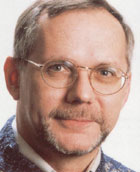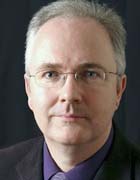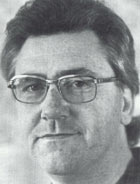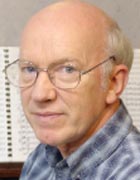2005 European Championships - Own choice selections
24-Apr-2005There are nine bands taking part this year, but only six pieces of own choice music will be used. However, two of them have never been heard here before and the rest are classics of their generation.
 Music of the Spheres - Philip Sparke
Music of the Spheres - Philip Sparke
(To be played by three bands)
Music of the Spheres was written late 2003/early 2004 and reflects the composer's fascination with the origins of the universe and deep space in general.
The title comes from a theory, formulated by Pythagoras, that the cosmos was ruled by the same laws he had discovered that govern the ratios of note frequencies of the musical scale. (‘Harmonia' in Ancient Greek, which means scale or tuning rather than harmony – Greek music was monophonic). He also believed that these ratios corresponded to the distances of the six known planets from the sun and that the planets each produced a musical note which combined to weave a continuous heavenly melody (which, unfortunately, we humans cannot hear). In this work, these six notes form the basis of the sections MUSIC OF THE SPHERES and HARMONIA.
The pieces opens with a horn solo called t = 0, a name given by some scientists to the moment of the Big Bang when time and space were created, and this is followed by a depiction of the BIG BANG itself, as the entire universe bursts out from a single point.
A slower section follows called THE LONELY PLANET which is a meditation on the incredible and unlikely set of circumstances, which led to the creation of the Earth as a planet that can support life, and the constant search for other civilisations elsewhere in the universe.
ASTEROIDS AND SHOOTING STARS depicts both the benign and dangerous objects that are flying through space and which constantly threaten our planet, and the piece ends with THE UNKNOWN, leaving in question whether our continually expanding exploration of the universe will eventually lead to enlightenment or destruction.
It was used for a first time by the Yorkshire Building Society Band at the 2004 contest.
 The Essence of Time – Peter Graham
The Essence of Time – Peter Graham
(To be played by one band)
Peter Graham wrote 'The Essence of Time' as the set work for the 1990 European Championships which were held in Falkirk in Scotland in 1990. Since that time it has proved to be one of the most popular test pieces for bands at the Championship and First Section level.
The piece takes it's inspiration from The Book of Ecclesiastes, Chapter 3 and commences: "To every thing there is a reason, and a season, and a time to every purpose under the heaven; a time to be born; a time to dance; a time to love; a time to hate; a time to die; a time to mourn; a time for war; a time for peace."
It is in effect a piece based on variations on a central theme which attempt to portray the individual characteristics of the moods of the activities listed. 'The Essence' is left to the interpreter and the listener to decide.
Although not seen as the most technically challenging of test pieces it is musically one of the most satisfying to listen to – the variations are both superbly constructed and rounded to feature both individual and ensemble strength and weaknesses. It requires an understanding of the composer's intentions and punishes those who indulge too much in over theatrical musical posturing. It has a beautiful simplicity in many of the more subdued movements whilst the faster variations are bright and witty.
Its popularity has been such that it has been used here in the Own Choice Section by Tredegar who came 3rd with it in 1991 and Stavanger in 1996, as well as it being used at the Grand Shield Contest in 1992. It has also been used as the First Section set work for the Pontins Championships in 1998 and as the National Championship First Section Finals test piece in 1994.
It was due to be used at the 2004 contest by Brass Band Normandie, but they withdrew from the contest due to the death in the family of the conductor.
 Concerto Grosso – Derek Bourgeois
Concerto Grosso – Derek Bourgeois
(To be played by two bands)
'Concerto Grosso' was written by the composer as far back as 1979, and was originally not a full brass band composition. The initial piece was in fact written for the Philip Jones Brass Ensemble, a ten-piece made up of four trumpets, 1 French horn, 4 trombones and a tuba and was written especially for Philip Jones' farewell concert.
Bourgeois was at that time the Professional Musical Director of the Sun Life Band in Bristol and when in 1990 the band was asked to perform on the BBC radio programme "Bandstand" the composer took the opportunity of re-scoring the work for full band.
Although an immense "tour de force" the composer believes it to be within the capabilities of most top class Championship bands, although he believes that organisers of the major contests have been reticent to use the piece due to its length – it is 20 minutes long. Written in three main parts it is played as a continuous piece and explores in each of its sections material that ranges from the technically brilliant to the sombre, beautiful melodic yet with a real sense of fun and wit. Each of the major solo players within a band has material that extends their capabilities to the limit whilst the ensemble is tested to the full. It remains today perhaps the most vividly brilliant of brass band compositions.
Due to its immense difficulty and length it comes as little surprise that it is rarely heard on a contest stage, with Eikanger giving it the European debut in 2000 when they won the own choice section of the contest in Birmingham and again by Yorkshire Building Society giving 2002 winning in Brussels, whilst Stavanger used it in 2003 to win the own choice section of the Norwegian Championships.
It was last used in the 2003 contest by the Yorkshire Building Society Band who came second with it in the own choice section of the contest.
 St. Magnus – Kenneth Downie
St. Magnus – Kenneth Downie
(To be played by one band)
This music is a set of variations on the tune known as St Magnus, which is attributed to Jeremiah Clarke. Most people will associate it with Thomas Kelly's hymn, which begins: "The Head that once was crowned with thorns Is crowned with glory now".
The tune is very simple, consisting of just two, four-bar phrases. Neither is there much in the way of rhythmic variety, every note being a crotchet with the exception of two quavers, and the last note in each phrase. Within such a simple structure, however, lies considerable strength.
Theme:
The listener is given the opportunity of hearing it twice, in full, at the beginning, starting with one player but soon taken up by the full ensemble. It returns in the middle of the music and is stated again near the end. This has been done quite deliberately in the hope that there will be an appreciation of what material is being developed, by the listener as well as by those with access to the score, who are able to see the visual connections.
Variation 1:
This takes the rhythm of the last part of the theme and also uses the shape of the opening as a recurring figure. The mood is whimsical and skittish, with short, teasing rhythmic figures tossed around the band, and quick interplay with percussion, at a fast tempo. An energetic flourish finishes this variation before the Andante espress.
Variation 2:
This commences with chords related to the opening of Variation 1. The cantabile on solo cornets establishes a new, lyrical mood and there is scope for expressive playing in a series of short solo passages. The theme works its way unobtrusively into the texture before a reprise of the solo cornet melody and some more lyrical interchanges between Eb tuba, euphonium, flugel horn and cornets. The variation ends serenely with clear references to the last phrase of the theme.
Variation 3: Allegro con moto
The first idea to dominate is clearly linked to the shape of the theme's first phrase. There is a frenetic feel to much of this variation, with considerable energy and instability created by extensive use of cross-rhythms. A thinning-out of the score marks a clear change to development of the start of the second phrase of the theme. This proves to be short-lived however, and the opening material returns leading to a restatement of the theme, "Maestoso" after which a euphonium cadenza links to:
Variation 4:
Here we have some solos for euphonium, cornet, trombone and tuba set against a background of horns and baritones presenting a pensive statement of the theme's opening.
Variation 5:
This commences Allegro, with lively work for cornet and euphonium spreading to the whole band before attention focuses on the beginning of the second phrase of the theme which is initially presented in diminution, then in regular rhythm, then in inversion. An increase in tempo coupled with a decrease in volume, requires dexterity and control, with several metrical challenges thrown in for good measure.
The same fragment of phrase becomes an ostinato, which generates a frenzied climax, punctuated by short, dramatic silence, before the opening figure returns and the music gradually winds down. The tubular bells herald the final return of the theme, in augmentation, marking the start of the:
Finale:
With the running semiquavers of the previous variation sounding in counterpoint. A fast, furious coda speeds the work to a conclusion while references to the opening of the theme are still trying to break into the texture of the music.
Ginnungagap…seeming emptiness – Johan Evenepoel
The piece was commissioned by Brass Band Buizingen in 2003 and was selected as the test piece for the Netherlands National Brass Band Championships in 2004.
The composer utilises sound space and antiphonal effects, dividing the band as a performing group into three sections: two of ‘Bright Brass' positioned around a central group of saxhorns. These groups explore such contrasting moods as, Hot/Cold; Virtuosity/Calm and Divine/Human.
Ginnungagap (‘seeming emptiness') in the cosmology of Norse mythology is the primordial void separating Niflheim and Muspell, the land of eternal ice and snow and the land of eternal heat and flame.
In the beginning, before the world of men and Gods existed, the spring Hvergelmir, deep in thefrozen wastes of Niflheim gave rise to eleven rivers known as the Elivagar. Over a long period of time, water of the Elivagar ran across Niflheim and poured into the northern part of Ginnungagap. The water froze, forming vast sheets of ice, creating a zone of melt water amid the ice and snow. Here life began, and the first living thing was a frost giant.
In Norse mythology, Ynir is the primordial giant and progenitor of the race of frost giants. He was created from the melting ice of Niflheim, when it came into contact with the hot air from Muspell. From Ymir's sleeping body the first giants sprang forth: one of his legs fathered a son on his other leg, whilst from under his armpit a man and a woman grew out.
The frost kept melting and from the drops the divine cow Audumla was created. From her udder flowed four rivers of milk, on which Ymir fed. The cow itself got nourishment by licking hoar frost and salt from the ice.
On the evening of the first day the hair of the man appeared, on the second the whole head and on the third it became a man, Buri, the first God. His grandchildren are Odin, Ve and Vili. Odin and his brothers had no liking for Ymir, nor the growing number of giants, and killed him.
In the huge amount of blood that flowed from Ymir's wounds all the giants, except two drowned. From the slain body the brothers created heaven and earth. Theyused the flesh to fill the Ginnungagap; his blood to create the lakes and the seas; from his broken bones they made the mountains; the giant's teeth and the fragments of his shattered bones became rocks and boulders and stones; trees were made from his hair, and the clouds from his brains.
Odin and his brothers raised Ymir's skulland made the sky from it and beneath its corners they placed a dwarf: Nordi, Sudri, Austri and Westri. At the heart of Ginnungagap, the struggle between Gods and Men would begin…
 Journey to the Centre of the Earth - Peter Graham
Journey to the Centre of the Earth - Peter Graham
The French novelist Jules Verne (1828 - 1905) created a unique blend of science and adventure in his series of novels known as "Voyages Extraordinaires". Written in 1864, Journey to the Centre of the Earth is on the surface an adventure story but as the commentator Diana Mitchell has observed on a deeper level can be seen as "man's journey of himself, always probing deeper for what lies at the centre".
The novel takes the form of a sequence of diary entries by Axel, nephew of Professor Otto Lidenbrock. The pair follow coded instructions in an old document guiding them to Iceland where, together with their guide Hans, they enter the open crater of an extinct volcano Snæfells and pursue a trail to the centre of the earth. There follows "hair-breadth scapes and ventures perilous" as the intrepid explorers encounter a vast interior world.
This music presents scenes from the novel in a rough chronological order. The work opens on the dark and brooding Summit of Snæfells and follows the adventurers as they descent into the bowels of the earth. En route they encounter the Wonders of the Terrestrial Depths (an electrically illuminated sky), a dream sequence during which Axel witnesses a Battle of Antediluvian creatures before the final Ascent and Homecoming. The key scene of the book (and the music) reflects on Axel's despair as he becomes separated from the his companions and is Lost in the Labyrinth. His subsequent rescue is due to an acoustic phenomenon whereby he hears the voices of his friends in The Whispering Gallery.
Journey to the Centre of the Earth is dedicated to Ryan and Megan, who love the story!
Peter Graham
Cheshire
March 2005















